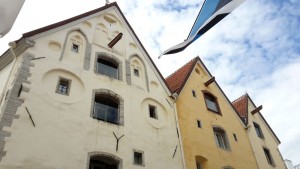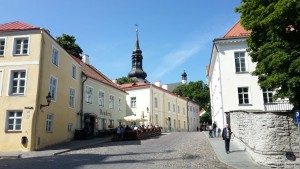Estonia has been very dear to my heart ever since I visited the first time in 2011. Since then, I’ve been telling everyone who wanted to hear it (or not) to visit Estonia. This year, I returned after 5 years and it’s still one of my favourite countries to visit. I was very lucky with the weather again. While rain and thunderstorms were raging over Germany, we had sun and 20+°C in the Baltics and I went for my first swim of the year on the Estonian coast in May.
The country is 51% covered with forest, has only 1,3 millon inhabitants (with about 430.000 in Tallinn) and a shallow coastline of nearly 4000 kms in addition to thousands of big and small lakes. Definitely a great place to get your mind off from a busy office job! Here is the first part of my travel guide to Estonia with focus on Tallinn and Tartu. I’ll combine both my experiences from 2011 and 2016.
Tallinn
Tallinn is the capital of Estonia and of course a must-see. Its cobbelstoned, medieval old town center is part of the Unesco world heritage and a great place to get a first insight into Estonia and its culture. Beware of the tourists though pouring in daily from the cruise ships. It can get quite packed during the main tourist season but the old town is refreshingly empty after 5pm when all the cruise ships have left. You’ll then have enough opportunities to explore the lower part (with the famous town hall) and the upper part, Toompea, where the upper class used to live in former times and where you’ll find the Estonian parliament and the Alexander Nevsky Cathedral. During the golden evening hours, Tallinn looks particularly beautiful from the viewing platforms of Toompea. The climb up the St. Olav’s church tower is also worth it as it offers a great view over the whole city from another perspective.
Other than the old town, I love to visit the Kadriorg park a bit further outside city center which you can reach by tram. Kadriorg has lots of lovely old traditional wooden houses to explore if you’re into architecture. In addition, the art museum is situated in the park as well as the residence of the Estonian president. From Kadriorg, you can directly walk to the city beach or hop on a bus to Pirita, a suburb of Tallinn and the swimming destination for the locals during summer.
This time around, I also went discovering the Kalamaja district, a former Russian workers quarter and now an up and coming artsy area called Telliskivi Creative City right behind the Tallinn train station. Old factory buildings are tastefully redesigned as shops and cafés as well as art workshops. Walk a bit further and you’ll find a district full of wooden heritage buildings and the Patarei Prison museum as well as the Seaplane Harbour, the naval museum of Tallinn (which I haven’t visited yet). Of course, Tallinn also has the usual Soviet style and newer business areas with a couple of high-rise buildings.
If you plan to stay more than two days in Tallinn, check out the Lahemaa National Park during a day trip or the super interesting open air museum Roca al Mare which is just a short bus trip away from the city center. I discovered Lahemaa National Park during a rainy day in 2011 but it was still wonderful, with its nature trails and old German manor houses.
Did you know that Estonia was under German rule for about 300 years from the 13th to 16th century as part of the Livonian Confederation? You’ll find quite a lot of traces of this heritage in the Estonian culture and language. Even under the Swedish rule during the 17th and 18th century, German was the official language for administration and education in Estonia. Still nowadays, you find references to the former German names of e.g. Reval (Tallinn) oder Dorpat (Tartu).
After being under alternating German, Swedish and Russian rule for centuries, Estonia gained independence shortly in 1918 before the Russian and German occupation during World War 2. After the war, Estonia became part of the Soviet Union and only regained independence in 1991. During the 1990s, the new Estonian government under the lead of President Lennart Georg Meri managed to overcome the economic crisis quickly and jump ahead the two other Baltic countries by focusing on the development of technology, integrating computer science in schools early on and setting up governmental and administrative functions online, the so called eGovernment initiative. Nowadays, you can even apply for Estonian eResidency and set up your company in Estonia from abroad. Isn’t that great?!
Laulasmaa
After a couple of weeks on the road in the Baltics and before jumping back into busy city life, I wanted to hang out at the coast for a bit longer. By serendipity, I discovered Laulasmaa only 25 kms outside Tallinn and reachable by bus. There, you’ll only find a spa hotel and a holiday center with a camping site. Both are only a short walk from the beach which was nearly completely empty at the end of May but the water warm enough to go for a swim. Alternatively, you can take extensive walks in the beach forest. A great place to relax!
Tartu
Tartu is situated in Southeast Estonia and the second biggest city in Estonia but small in German dimensions with only about 99.000 inhabitants. To get there, you can hop on a 2 hours bus from Tallinn. I love the super well functioning bus network in Estonia! Tartu has a few sights to discover, including the Dome Church’s ruins, Jaani Church and the bronze sculpture of Oscar Wild and Eduard Vilde. The most famous sight of Tartu is the sculpture of kissing students in front of the town hall. Tartu also has a big student community which makes for a lively, buzzing atmosphere and it is situated in the middle of a diverse nature.
During my stay there in 2011, I went on two day trips outside the city. One with the bus to Lake Karijärv and the other one by train to the Valgemetsa area south of Tartu. Both are wonderful places for walks in the forest and to swim in (one of) the lake(s) there.
From Tartu, you can also go on day trips to Lake Peipus which is the biggest transboundary lake in Europe on the border between Estonia and Russia on the other side. I missed the opportunity to visit in 2011 but will catch up on it after my return to Estonia at the end of June.
I’d love to hear from you in the comments if you’ve been to Estonia and where. I’m also glad to share my accommodation recommendations on request. Booking.com is a great platform to find nice accommodations in all the Baltic countries.
The second part of my travel guide to Estonia with focus on Pärnu, Saaremaa and Haapsalu will follow during the upcoming days. Stay tuned! (Update June 13: The second part is now online as well as a third part with focus on some of the Estonian islands.)
© All photo rights belong to Kathleen Fritzsche.












































Went on my lifetime hertage trip to Estonia in July 2014- it was the trip of a lifetime!! Songfest, Dancefest, Tallinn, round trip to Tartu, then drove to ferry to go to Saaremaa! Saw my father’s house he was born in, on Saaremaa, visited 2 sets of second cousin relatives, had whole island tour, swam in the Baltic Sea. Fantastic trip and meant so much to me! My parents were both Estonian, and my only regret is that I was not able to share that trip with them- but they have died and are gone. Love your pics and words! I hope to be able to go back someday! I felt like I belonged there! Are you Estonian or just in love with the country?
Thanks so much for the kind words, Grace! Really glad that you liked the post! I’m not Estonian but indeed in love with the country since I visited first in 2011 🙂
Thanks for your Travel Guide to Estonia, I found it very interesting, I am travelling to Tallinn next Thursday.
Thanks Enric! Enjoy the city, it has so many great sights and things to offer!